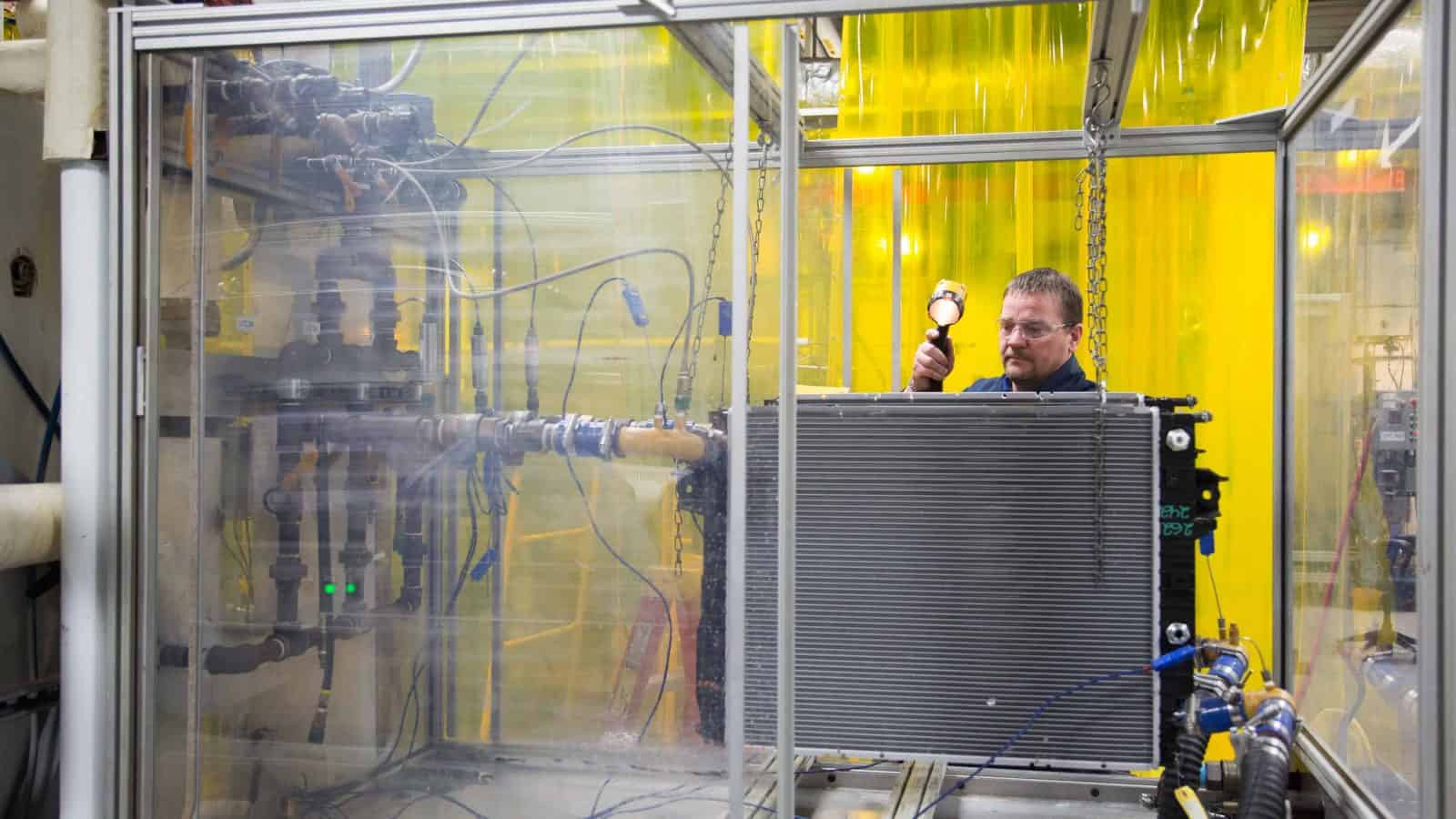Manufacturers: Nuclear Energy Orders Power Up Manufacturing in America
Washington, D.C. – The National Association of Manufacturers today welcomed President Trump’s latest executive orders to expand the development of nuclear energy, streamline federal permitting and strengthen domestic fuel production. NAM President and CEO Jay Timmons issued the following statement:
“These actions mark an important and timely step toward unleashing American energy dominance safely and responsibly. Nuclear-generated power is an important part of an all-of-the-above energy strategy, which is necessary to meet the power needs of a growing manufacturing sector, and the nuclear fuel supply chain is a critical manufacturing industry that we need to bring home.
“The executive orders include measures to accelerate the licensing of next-generation nuclear reactors, open federal lands for energy infrastructure and increase domestic uranium production. Together, these actions address critical supply chain challenges and energy demands—particularly as the AI-driven economy continues to grow.
“Rebalancing regulations and expediting permitting reform to unleash American energy are key pillars of a comprehensive manufacturing strategy that Congress must act on so manufacturers can grow, hire and compete—and these orders reflect that vision by reforming the licensing and permitting systems that place burdens on manufacturers.
“The NAM looks forward to working closely with the National Energy Dominance Council, under the leadership of Secretary of the Interior Doug Burgum and Energy Secretary Chris Wright, as well as Congress to ensure these policies translate into durable results for manufacturers.”
Background:
Most recently, support for nuclear energy in the U.S. has climbed to 61% according to Gallup, reaching just one point below the all-time high in 2010. Support for accelerating the development and commercialization of both traditional nuclear energy plants as well as advanced modular reactors is vital to America’s energy future and the success of manufacturers in the U.S.
The NAM has long championed policies that drive investment in advanced nuclear power to meet rising U.S. energy demand fueled by electrification, advanced manufacturing and the surge in AI and data centers.
These include:
- Reforming the permitting and approval process to make it easier for reactor projects to locate on underused or abandoned sites;
- “Early licensing work” provisions to help deploy reactors more quickly at national security infrastructure sites; and
- A series of awards to encourage companies to develop advanced-reactor technology.
-NAM-
The National Association of Manufacturers is the largest manufacturing association in the United States, representing small and large manufacturers in every industrial sector and in all 50 states. Manufacturing employs nearly 13 million men and women, contributes $2.93 trillion to the U.S. economy annually and accounts for 53% of private-sector research and development. The NAM is the powerful voice of the manufacturing community and the leading advocate for a policy agenda that helps manufacturers compete in the global economy and create jobs across the United States. For more information about the NAM or to follow us on Twitter and Facebook, please visit www.nam.org.
FERC Advances Louisiana LNG Project

The Federal Energy Regulatory Commission has issued a new final supplemental environmental review for Venture Global’s CP2 liquefied natural gas project in Louisiana, bringing it a step closer to reality (E&E News, subscription).
What’s going on: FERC found that “the terminal and an associated compressor station wouldn’t cause ‘significant cumulative air quality impacts.’”
The project: “The CP2 facility has a nameplate liquefaction capacity of 20 million metric tons per year, but it could produce even more under peak conditions.”
- If approved expeditiously, the project could produce its first LNG by 2026, the company said last year.
- “With today’s [final environmental impact statement,] FERC has found twice-over that CP2 will have no significant air impacts,” Venture Global spokesperson Jess Szymanski said in an emailed statement to E&E News. “The project is ready to break ground and begin supplying U.S. allies with much-needed LNG as soon as the FERC Commission votes on the Final Order and issues a notice to proceed with construction.”
What’s next: The Final Order is slated for July, according to FERC’s website.
The NAM says: “LNG projects like Venture Global’s will help bolster the American economy by creating jobs here at home and enabling the U.S. to achieve energy dominance on the world stage,” said NAM Director of Energy and Resources Policy Michael Davin.
Hydro CEO: U.S. Must Reuse More Aluminum
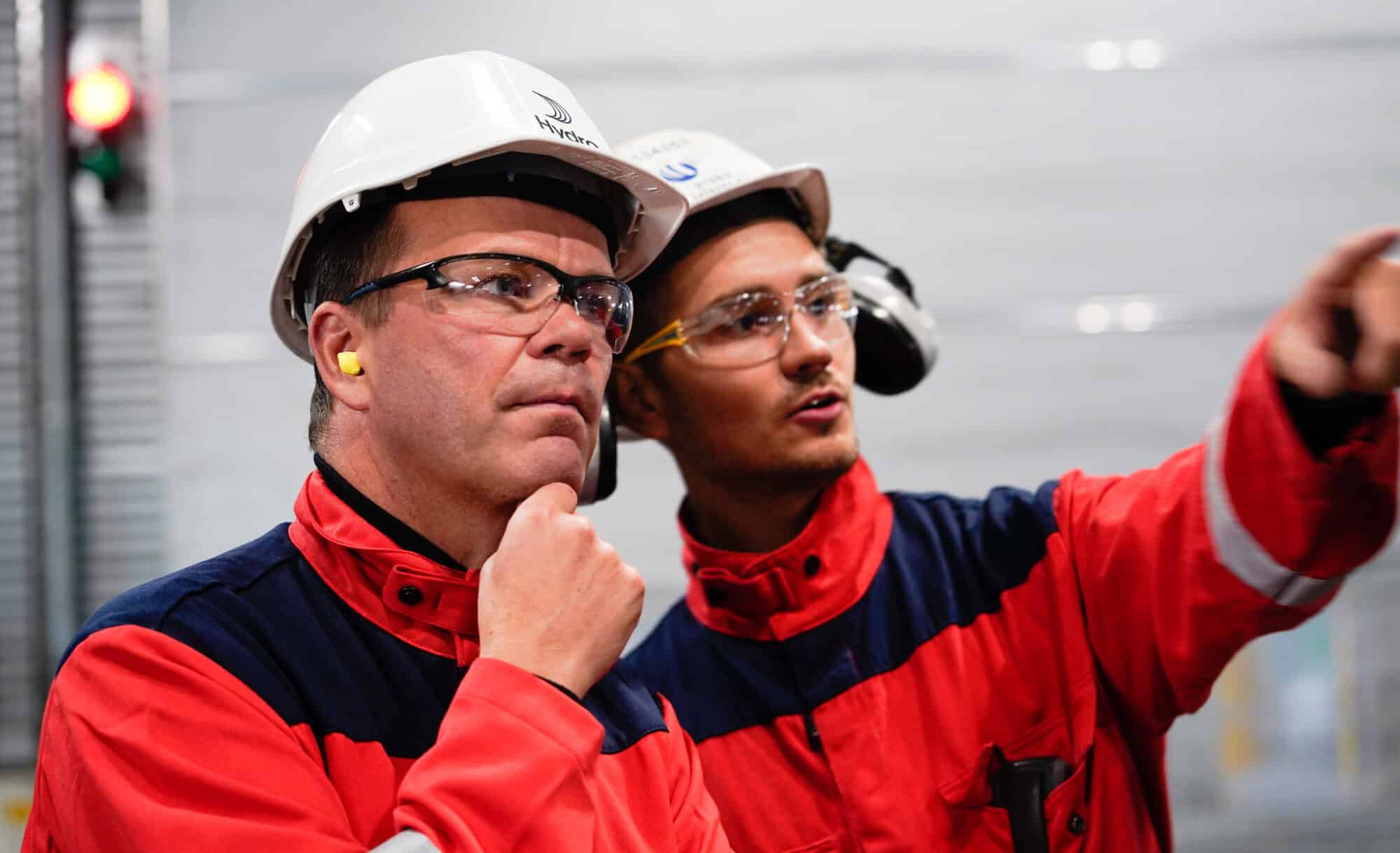
Aluminum is “an essential part of everything we do”—so we need to recycle more of it.
That’s the message from leading global aluminum and renewable energy company Hydro, based in Oslo, Norway, whose president and CEO, Eivind Kallevik, recently sat down with the NAM to discuss the importance of the metal to the U.S.
Ubiquitous and crucial: “Construction, automobiles, [energy and technology]—you’ll find an enormous amount of aluminum in all of that,” Kallevik told us. “Going forward, it will just become increasingly important.”
An energy imperative: The U.S. has an aging electrical grid—a matter on which the NAM has long issued a clarion call—and modernizing and expanding it to meet Americans’ energy appetite will require aluminum, and a lot of it.
- “There’s going to be a huge increase in demand for electricity, especially given [the growth in construction of] data centers,” said Kallevik.
- For vehicles to become more energy-efficient, they must be lighter, and “the best way of doing that is more aluminum.”
A workhorse: One of the metal’s best qualities is its ability to withstand nearly endless reuse, Kallevik said.
- “You can recycle it infinitely. If you sort it the right way, you will be able to take it back to exactly the same state it was in in the first place.”
- Hydro—which has operations in 17 states and employs thousands of people in the U.S.—has multiple aluminum recycling facilities throughout the country, including at sites in Pennsylvania, Indiana, Illinois, Louisiana, California and Texas.
Keep more at home: “The more [aluminum] you can keep onshore, the better it is” for manufacturing, the economy in general and national security, Kallevik continued, adding that aluminum is critical in many U.S. defense applications.
- “If the U.S. kept more scrap exports onshore, we would reduce dependence on third parties” for the metal, he said.
Policy and supply chains: Because building is a heavily energy-intensive process, “energy policy is going to be increasingly important” in the coming years, Kallevik went on.
- “To protect its industries, the U.S. needs to ensure a fair regulatory framework to ensure that everybody in a global context competes on a level playing field,” he told the NAM.
- And when it comes to shoring up domestic supplies of aluminum, “to be more self-sufficient, the short-term solution for the U.S. is recycling,” he said. “Use what’s on the ground today, and for tomorrow, build capacity.”
President’s Executive Order Strengthens U.S. Manufacturing by Accelerating Permitting and Unlocking Critical Resources
Washington, D.C. – Following President Donald Trump’s executive order to accelerate permitting and expand access to critical resources for manufacturing, National Association of Manufacturers President and CEO Jay Timmons released the following statement:
“For too long, red tape and burdensome regulations have stood in the way of the basic building blocks that power manufacturing in the United States, especially mining and processing the minerals manufacturers rely on to create jobs and dominate on the world stage. The administration is addressing those barriers, making it easier for manufacturers to access the resources we need to build the future in America.
“The NAM and our members will continue to serve as a resource to the Trump administration as it takes action to secure America’s supply chains and reduce reliance on countries like China when we have resources right here at home.
“A comprehensive manufacturing strategy—one that cements America’s position as the manufacturing superpower—depends on smart permitting reforms like the ones the administration is advancing. When manufacturers in the United States can invest with certainty, they plan, hire and win—and when manufacturers win, America wins.
“The NAM has long championed expediting the permitting process as a key pillar of our competitiveness agenda. When President Trump spoke at our September 2024 board meeting, he promised to deliver on this priority, and he has kept his promise. We look forward to continuing to work with his National Energy Dominance Council, under the leadership of Secretary of the Interior Doug Burgum and Secretary of Energy Chris Wright, to Make America Great for Manufacturing Again.”
-NAM-
The National Association of Manufacturers is the largest manufacturing association in the United States, representing small and large manufacturers in every industrial sector and in all 50 states. Manufacturing employs nearly 13 million men and women, contributes $2.93 trillion to the U.S. economy annually and accounts for 53% of private-sector research and development. The NAM is the powerful voice of the manufacturing community and the leading advocate for a policy agenda that helps manufacturers compete in the global economy and create jobs across the United States. For more information about the NAM or to follow us on Twitter and Facebook, please visit www.nam.org.
Burgum Talks Taxes, Permitting and More

At an NAM-sponsored breakfast at energy conference CERAWeek in Houston on Tuesday, Interior Secretary Doug Burgum assured NAM board members that the administration has a manufacturing strategy in place, particularly regarding permitting, infrastructure development and manufacturers’ access to reliable and affordable energy.
A comprehensive strategy: In his remarks opening the event, NAM President and CEO Jay Timmons discussed the five-pillar, comprehensive manufacturing strategy that the NAM has been urging the Trump administration to implement.
- “Secretary Burgum, I just want you to know we’ve been making the case for a coordinated, comprehensive manufacturing strategy to give us the predictability and the certainty that manufacturers need to plan, to invest and to hire here in the United States, and that strategy has five pillars—goals that I know you share,” Timmons said.
- The goals are making the 2017 tax reforms even more competitive and permanent; securing regulatory certainty; expediting permitting reform to unleash American energy dominance; increasing the talent pool; and implementing a commonsense trade policy—to expand access to markets while keeping manufacturing competitive.
- Timmons warned of the dire consequences the U.S. economy and manufacturers will face if lawmakers fail to extend the 2017 tax reforms. Among them: the loss of some 6 million American jobs, according to a recent NAM–EY study.
An economic backbone: “Manufacturing, as you know, has been the backbone” of the economy, Burgum said. “President Trump ran on bringing manufacturing back to the United States. His policies are driving to do that.”
Unleashing U.S. energy: Timmons praised President Trump for his day-one lifting of the previous administration’s liquefied natural gas export permit moratorium.
- The “recent NAM LNG study found that the U.S. LNG export industry could support more than 900,000 jobs and add $216 billion to GDP by 2044,” he said.
- Said Burgum: “We are looking at everything to try to, for the first time, [have] streamlined government. … [and] it’s happening. It’s happening quickly.”
“Optimistic about the future”: The administration’s commitment to “low taxes and cutting red tape”—on which President Trump’s recently created National Energy Dominance Council is focusing—“are all things that are going to help lower your cost and create opportunities,” Burgum continued.
- “Capital is flowing to the U.S. at record levels. … I’m very optimistic about the future.”
The last word: At another event at CERAWeek, a roundtable sponsored by Natural Allies for a Clean Energy Future, Timmons summed up manufacturers’ commitments.
- “Yes, we care about developing our natural resources to power our economy, certainly through manufacturing, but it’s also about people, here in the United States and around the world,” said Timmons. “The energy that we export, that is soft power for the United States. That expands our influence. That allows us to export not only our energy, but also our values. So I think that’s very, very important for our future.”
EPA Reconsiders Dozens of Burdensome Regulations
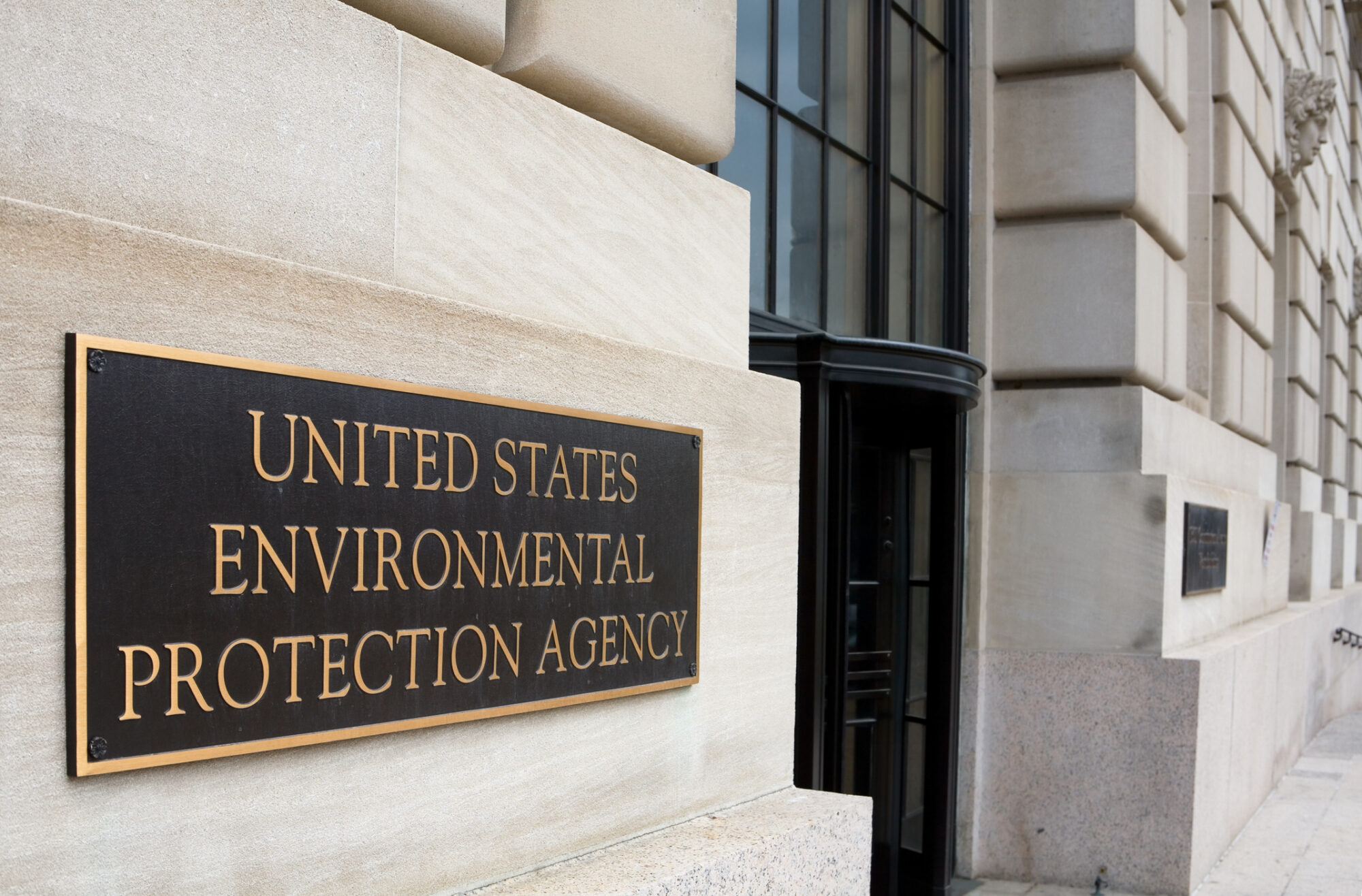
The Environmental Protection Agency announced Wednesday it would begin a large-scale, NAM-supported review of dozens of rules and regulations, including the previous administration’s unworkable National Ambient Air Quality Standards for particulate matter and an overly burdensome power plant emissions rule (EPA).
What’s going on: In response to sustained advocacy from the NAM and manufacturers around the U.S., EPA Administrator Lee Zeldin said in a press release and Wall Street Journal (subscription) op-ed that he intends to take swift action to review and potentially rescind regulations that were hamstringing manufacturers and needlessly driving up costs across the board.
What’s in it: The NAM in December called on President Trump to reverse the regulatory onslaught of the past four years. NAM-recommended actions included in yesterday’s EPA announcement included reconsideration of the following:
- NAAQS for PM2.5: Last year, the Biden administration tightened the primary annual standard for particular matter—more commonly known as soot—to an untenable 9 micrograms per cubic meter from 12 micrograms per cubic meter. Manufacturers found to be in nonattainment of these standards will now be denied permits for new and expanded facilities.
- Power plant rules: The previous administration’s emissions regulations on existing coal-fired and new natural gas–powered power plants include an unrealistic timeline for the widespread adoption of expensive, unproven new technology; this regulation threatens grid reliability and the ability of manufacturers to receive power for their operations.
- Vehicle regulations: Current regulations of light-, medium- and heavy-duty vehicles impose costly hardships on auto manufacturers.
- Waters of the United States: The last administration had made the scope of the Clean Water Act overly broad, resulting in high costs and even slowed permitting processes.
Our view: “President Donald Trump and EPA Administrator Lee Zeldin have answered the calls of manufacturers across the country to rebalance and reconsider burdensome federal regulations harming America’s ability to compete,” NAM President and CEO Jay Timmons said in a statement picked up by The Washington Post (subscription).
New House AI, Energy Working Group Issues RFI
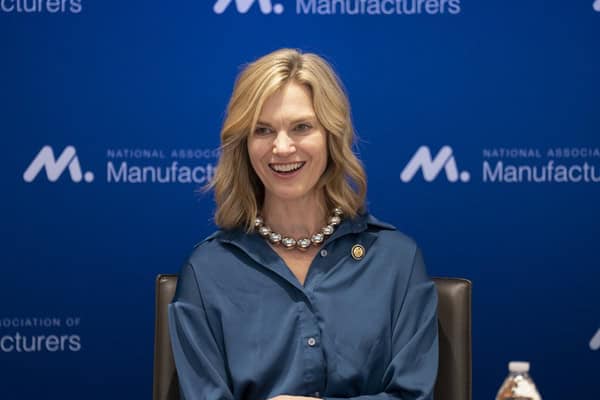
The newly established House of Representatives’ AI and Energy Working Group is seeking information on the increase in energy demand we can expect due to the growing use of artificial intelligence (POLITICO Pro, subscription).
What’s going on: Group lead Rep. Julie Fedorchak (R-ND)—who was North Dakota’s head utility regulator for more than a decade prior to being elected to Congress last year—discussed the new working group with us Tuesday at NAM headquarters.
- Rep. Fedorchak spoke at an event at the NAM on how the U.S. can strengthen the electrical grid, advance permitting reform and support manufacturers investing in the latest energy technologies.
- The working group issued a request for information on Monday, “invit[ing] stakeholders to provide written responses” to questions under “three pillars,” according to the RFI document.
The details: These pillars are the following:
- American Energy Dominance and AI Energy Demands: The RFI “seeks to identify strategies to secure a stable, affordable and sustainable domestic energy supply capable of powering next-generation AI infrastructure.” Subtopics on which respondents are asked to inform the working group include oil and gas, nuclear, solar, geothermal and other power production methods.
- Securing the Energy Grid: A resilient, secure electrical grid is “essential” for AI systems and the larger “digital economy,” the document says. Permitting reform, electricity generation and baseload power are possible subtopics here.
- Strategic Competition: Outpacing China: “In an era of intensifying global rivalry, ensuring American technological and energy leadership is critical.” Some of the subtopics under this pillar are manufacturing, critical minerals and chips.
Why it’s important: “To be AI dominant, we must first be energy dominant,” Rep. Fedorchak said in a statement, according to POLITICO Pro.
- “In 2024, data centers accounted for 4.3% of total U.S. power demand, and analysts predict this could climb to as much as 12% by 2030—more electricity than the entire state of Texas uses today. Yet the U.S. isn’t scaling up reliable baseload power quickly enough to support this rapid growth.”
How to respond: Responses are due by May 15 and should be emailed to [email protected].
Manufacturers to Trump and Congress: Act Now on Comprehensive, Commonsense Manufacturing Strategy as Tariffs Hit Manufacturing Industry
National Association of Manufacturers President and CEO Jay Timmons released the following statement ahead of President Donald Trump’s address to a joint session of Congress:
“The stakes couldn’t be higher for manufacturers right now. Many manufacturers are operating on thin margins, and the tariffs imposed today will further strain their resources. For example:
- A large manufacturer in the power-engineering sector that imports more than $100 million every year in components and products from Mexico now faces increasing costs of $25 million due to the tariffs. As a major supplier to the U.S. utility and industrial market, this will directly impact the ability for domestic utilities and industrial customers to maintain a safe, efficient and secure power grid.
- Another large consumer goods manufacturer indicated the tariffs on Mexico will cost their company $200 million, and the Canadian retaliatory tariffs will add another $31 million—totaling $231 million, or $1.15 million per day.
- A small copper manufacturer had nine truckloads of copper rod sitting at the Canadian border waiting to go through Customs when the tariffs went into effect, leading to 388,000 pounds of copper goods being returned to the supplier. If the tariffs remain in effect, bringing copper—a critical manufacturing input—into the U.S. would cost the manufacturer nearly $50,000 per truckload going forward.
“To mitigate the adverse effects of today’s tariffs, manufacturers call on President Trump and Congress to implement a comprehensive manufacturing strategy that would create predictability and certainty to invest, plan and hire in America. This strategy includes the following actions:
- Make President Trump’s 2017 tax reforms permanent and more competitive now. When President Trump signed these tax cuts into law, it was rocket fuel for manufacturing in America and made the U.S. economy more competitive on a global scale. That fuel is about to run out as key provisions have expired, and others are about to lapse. If Congress fails to act, it will cost America 6 million jobs, including more than 1.1 million manufacturing jobs. We must ensure these historic, pro-growth manufacturing provisions are made permanent and even more competitive so manufacturers can plan, grow and succeed.
- Restore regulatory certainty. Manufacturers are spending $350 billion each year just to comply with regulations—money that could be spent on expanding factories and production lines, hiring new workers or raising wages. President Trump has taken action already to streamline burdensome regulations starting with lifting the liquefied natural gas export ban, but we need to move faster to deliver on our industry’s potential.
- Expedite permitting reform to unleash American energy. President Trump is already ending the war on America’s energy producers, but there is more work to do. America should be the undisputed leader in energy production and innovation, but we will not reach our full potential without permitting reform. We are seeing opportunities for energy dominance fade in the face of a permitting process that takes 80% longer than other major, developed nations.
- Strengthen the manufacturing workforce. Over the past year, we have averaged 500,000 open manufacturing jobs in America—well-paying, life-changing careers. Manufacturers are struggling to fill critical jobs. We need a real workforce strategy that ensures we have the talent to grow, compete and lead.
- Implement commonsense trade policies that open global markets fairly and effectively. Building things in America only works if we can sell them around the world. That’s why we’re urging President Trump and Congress to provide greater predictability and a clear runway for manufacturers to adjust to new trade realities, while also making way for exemptions for critical inputs, enabling reciprocity in manufacturing trade.
“Manufacturers are investing in America in record numbers, and President Trump is focused on strengthening manufacturing in the United States to grow our nation’s economy. We look forward to working with President Trump as he works to advance policies that will help manufacturers thrive and prosper because when manufacturing wins, America wins.”
-NAM-
The National Association of Manufacturers is the largest manufacturing association in the United States, representing small and large manufacturers in every industrial sector and in all 50 states. Manufacturing employs nearly 13 million men and women, contributes $2.93 trillion to the U.S. economy annually and accounts for 53% of private-sector research and development. The NAM is the powerful voice of the manufacturing community and the leading advocate for a policy agenda that helps manufacturers compete in the global economy and create jobs across the United States. For more information about the NAM or to follow us on Twitter and Facebook, please visit www.nam.org.
Manufacturers: National Energy Dominance Council Shows President Trump’s Commitment to American Energy Leadership and Manufacturing Growth
Washington, D.C. – National Association of Manufacturers President and CEO Jay Timmons released the following statement on President Donald Trump’s recent executive order establishing the National Energy Dominance Council:
“President Trump is moving quickly to unleash America’s full energy potential by establishing the National Energy Dominance Council, setting America up to lead on energy and secure our energy independence. This action demonstrates President Trump and his administration’s commitment to ensuring manufacturers have the energy they need to drive economic growth.
“On day one, President Trump declared the United States will be a manufacturing nation, lifting the moratorium on liquefied natural gas (LNG) export permits—one of the NAM’s top recommended regulatory actions for the Trump administration to tackle. This was a significant move that will bolster our energy sector, strengthen our position in the global market and ensure manufacturers in America have the energy resources they need to power economic growth here at home. We look forward to working with President Trump and the administration to improve the processes for permitting for all energy sources, which this action also addresses. The federal permitting system is broken—delaying projects that would create jobs, secure supply chains and reinforce America’s competitive edge.
“The National Energy Dominance Council, under the leadership of Interior Secretary Burgum and Energy Secretary Wright, will help power the future of manufacturing in America because when manufacturing wins, America wins.”
-NAM-
The National Association of Manufacturers is the largest manufacturing association in the United States, representing small and large manufacturers in every industrial sector and in all 50 states. Manufacturing employs nearly 13 million men and women, contributes $2.93 trillion to the U.S. economy annually and accounts for 53% of private-sector research and development. The NAM is the powerful voice of the manufacturing community and the leading advocate for a policy agenda that helps manufacturers compete in the global economy and create jobs across the United States. For more information about the NAM or to follow us on Twitter and Facebook, please visit www.nam.org.
Trump “Unleashes” U.S. Energy
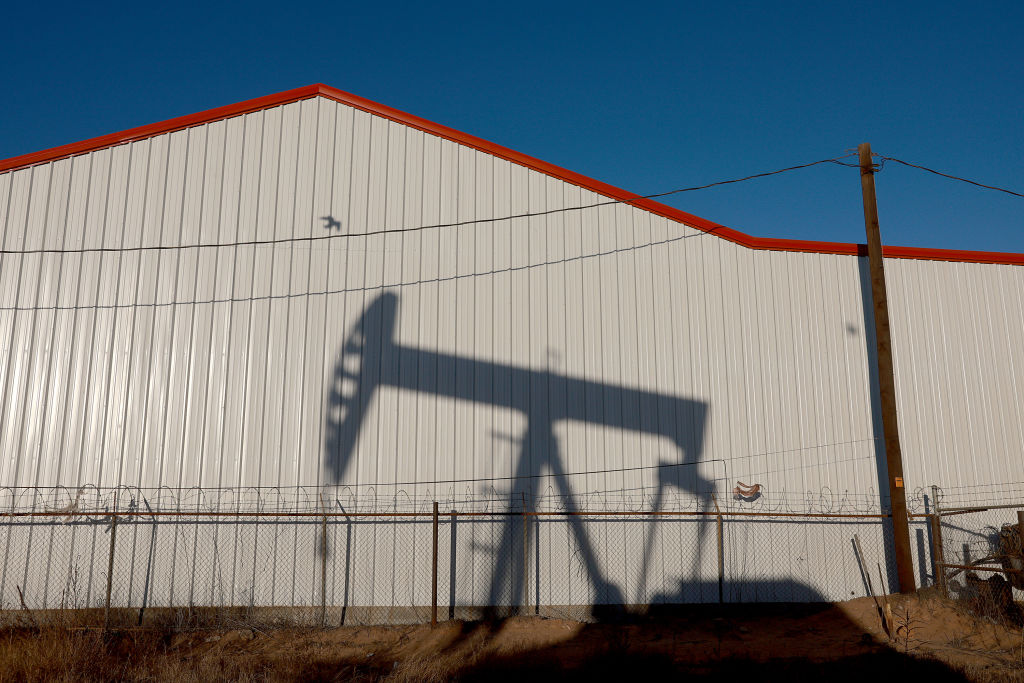
Among President Trump’s Day One executive orders were several manufacturing-crucial energy policies. We break them down here.
Domestic energy resources: The president focused on unlocking the vast wealth of energy resources in the United States with the “Unleashing American Energy” executive order, which:
- Orders a 30-day review by all federal departments and agencies of regulations and other barriers to the identification and development of domestic energy resources (particularly oil, coal, natural gas, biofuels, critical minerals, nuclear and hydropower);
- Directs the Department of Energy to resume liquefied natural gas export permits, ending the previous administration’s moratorium, and resumes review of LNG export applications;
- Rescinds the “NEPA Phase 2” rulemaking, the Council on Environmental Quality’s revisions to the National Environmental Policy Act;
- Directs the reconsideration of the legality of regulating greenhouse gas emissions under the Clean Air Act;
- Revokes an executive order by President Carter that gives the CEQ authority to issue binding regulations to other agencies;
- Terminates state emissions waivers that limit the sale of gas-powered vehicles and begins the process of unwinding a suite of vehicle tailpipe regulations from the previous administration;
- Directs all agencies to provide the opportunity for public comment and rigorous, peer-reviewed scientific analysis for regulations; and
- Disbands the Interagency Working Group on the Social Cost of Greenhouse Gases.
A “National Energy Emergency”: The president’s declaration of a “national energy emergency”:
- Authorizes the heads of every federal agency and department to use emergency powers to facilitate domestic energy development and production;
- Requires the Environmental Protection Agency and DOE to consider issuing emergency fuel waivers to allow for year-round sale of E15 fuel with a blend of 15% ethanol;
- Requires a report from the Army Corps of Engineers and other agencies on potential and planned permitting provisions to speed up energy infrastructure permitting under various legislative measures; and
- Requires agencies to use emergency authority under the Endangered Species Act to expedite energy project permitting consultations.
Alaskan energy: The president’s “ Unleashing Alaska’s Extraordinary Resource Potential” order provides for the opening of Alaskan lands to energy exploration and development and promotes Alaskan LNG production.
The Paris Agreement: “Putting America First in International Environmental Agreements” withdraws the U.S. from the Paris Agreement, a 2015 climate change accord.
Rescissions: “Initial Rescissions of Harmful Executive Orders and Actions” includes revisions of multiple executive orders put in place by the previous administration, including “Tackling the Climate Crisis at Home and Abroad,” “Establishment of the Climate Change Support Office,” “Climate-Related Financial Risk” and “Strengthening American Leadership in Clean Cars and Trucks.”
Offshore wind: The “Temporary Withdrawal of All Areas on the Outer Continental Shelf from Offshore Wind Leasing and Review of the Federal Government’s Leasing and Permitting Practices for Wind Projects” blocks lease sales for offshore wind projects and pauses new approvals for leases, permits or loans for on- and offshore wind projects.
Our view: “Expanding domestic energy production drives innovation, creates jobs and powers the growth that keeps America at the forefront of the global economy,” NAM President and CEO Jay Timmons wrote in a social post Monday.
- “Energy is the lifeblood of our industry, and we look forward to working with President Trump to build our manufacturing nation.”
